Abstract
The action of 5-hydroxytryptamine (5-HT) on an insect salivary gland was associated with a rise in adenosine-3′:5′-cyclic monophosphate (cAMP) concentration and an increase in calcium uptake. An increase in secretion induced either by 5-HT or exogenous cAMP required extracellular calcium. Both 5-HT and exogenous cAMP increased 45Ca efflux from previously labeled glands, but only 5-HT caused an increase in calcium uptake. The transepithelial potential in this tissue became more negative after addition of 5-HT, but more positive after addition of cAMP. 5-HT and cAMP induced a more negative potential when calcium was removed from the medium. It was concluded that both calcium and cAMP serve as intracellular messengers when 5-HT acts upon fly salivary gland.
Keywords: membrane permeability, adenylate cyclase, blowfly, protein kinases
Full text
PDF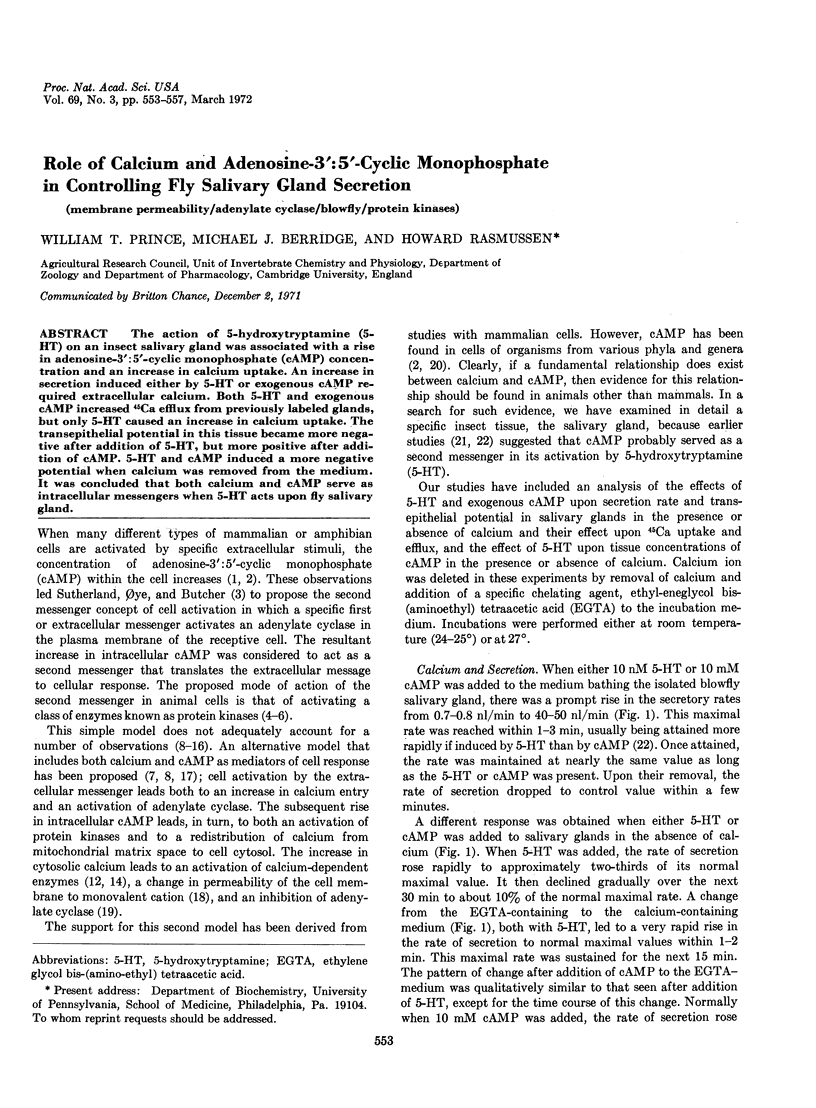
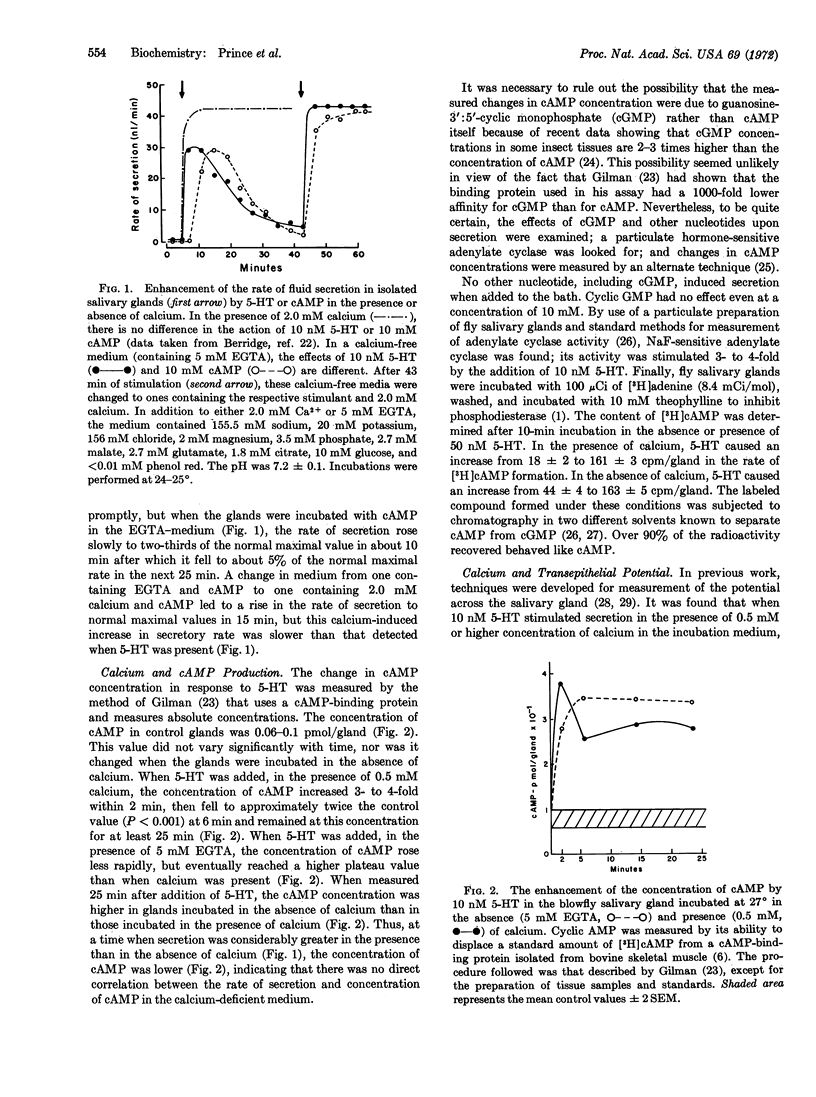
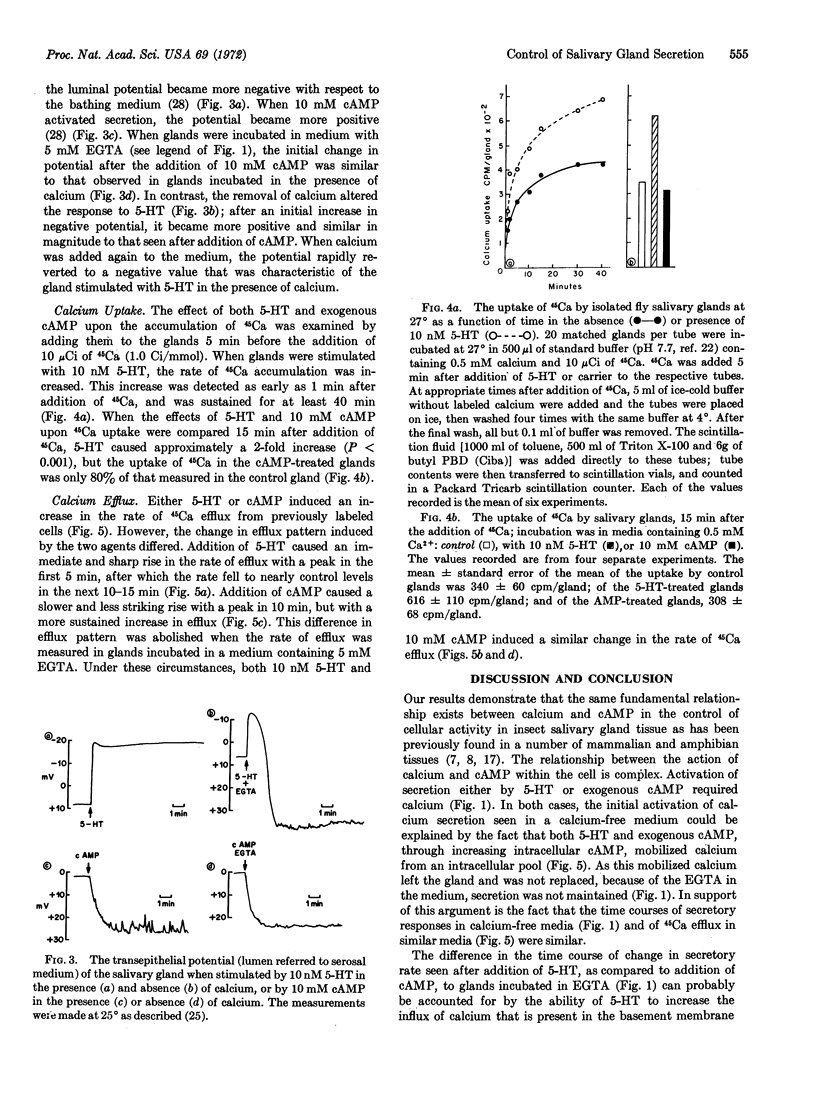
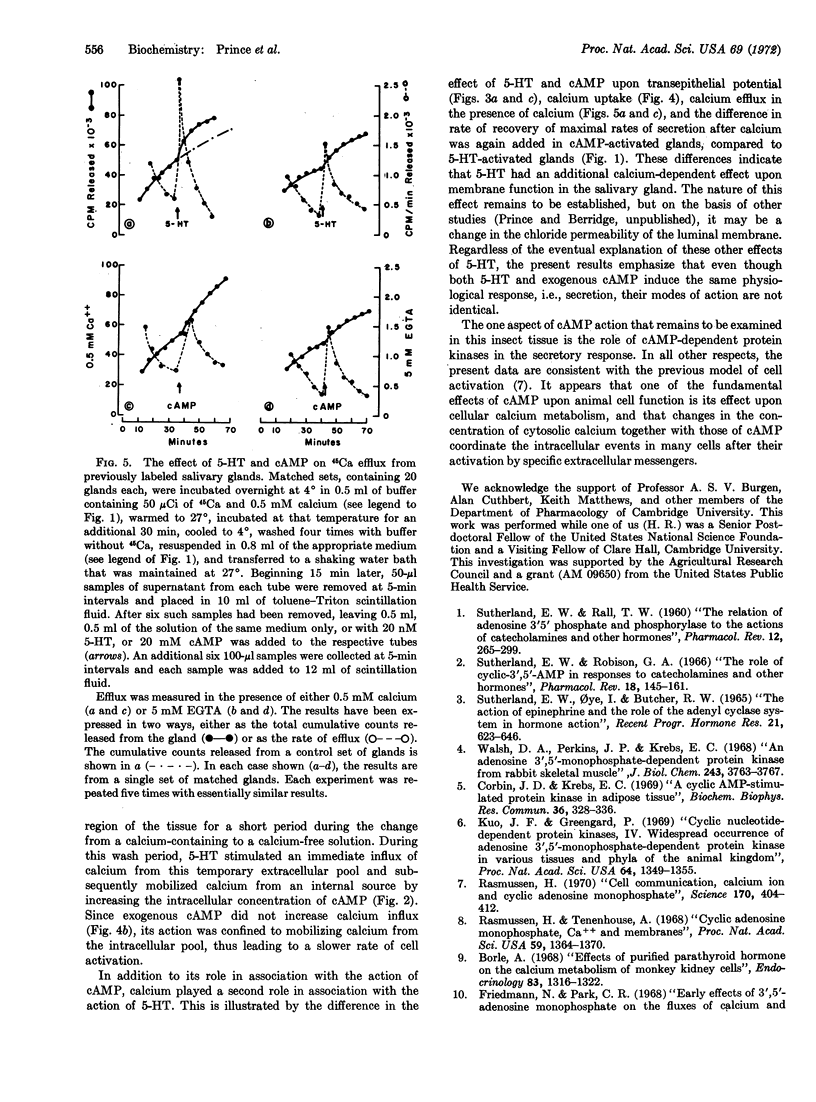
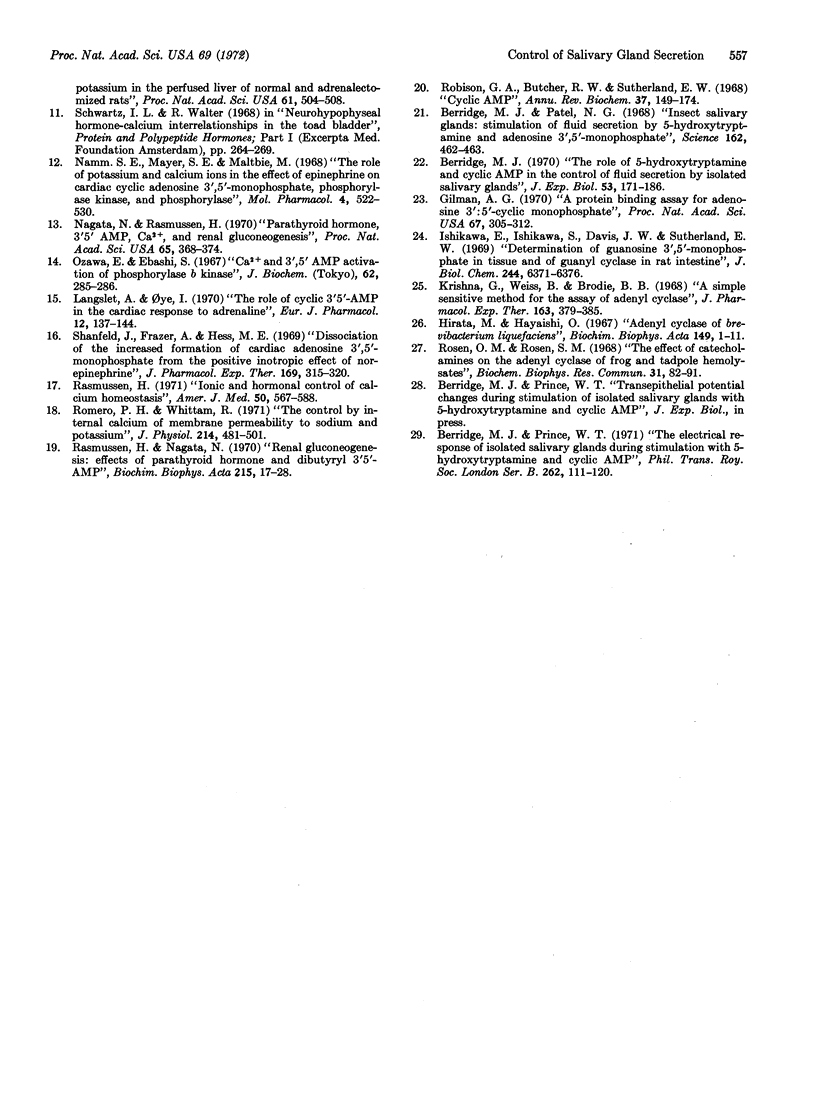
Selected References
These references are in PubMed. This may not be the complete list of references from this article.
- Berridge M. J., Patel N. G. Insect salivary glands: stimulation of fluid secretion by 5-hydroxytryptamine and adenosine-3',5'-monophosphate. Science. 1968 Oct 25;162(3852):462–463. doi: 10.1126/science.162.3852.462. [DOI] [PubMed] [Google Scholar]
- Berridge M. J., Prince W. T. The electrical response of isolated salivary glands during stimulation with 5-hydroxytryptamine and cyclic AMP. Philos Trans R Soc Lond B Biol Sci. 1971 Aug 20;262(842):111–120. doi: 10.1098/rstb.1971.0082. [DOI] [PubMed] [Google Scholar]
- Berridge M. J. The role of 5-hydroxytryptamine and cyclic AMP in the control of fluid secretion by isolated salivary glands. J Exp Biol. 1970 Aug;53(1):171–186. doi: 10.1242/jeb.53.1.171. [DOI] [PubMed] [Google Scholar]
- Borle A. B. Effects of purified parathyroid hormone on the calcium metabolism of monkey kidney cells. Endocrinology. 1968 Dec;83(6):1316–1322. doi: 10.1210/endo-83-6-1316. [DOI] [PubMed] [Google Scholar]
- Corbin J. D., Krebs E. G. A cyclic AMP--stimulated protein kinase in adipose tissue. Biochem Biophys Res Commun. 1969 Jul 23;36(2):328–336. doi: 10.1016/0006-291x(69)90334-9. [DOI] [PubMed] [Google Scholar]
- Gilman A. G. A protein binding assay for adenosine 3':5'-cyclic monophosphate. Proc Natl Acad Sci U S A. 1970 Sep;67(1):305–312. doi: 10.1073/pnas.67.1.305. [DOI] [PMC free article] [PubMed] [Google Scholar]
- Hirata M., Hayaishi O. Adenyl cyclase of Brevibacterium liquefaciens. Biochim Biophys Acta. 1967 Nov 21;149(1):1–11. doi: 10.1016/0005-2787(67)90685-5. [DOI] [PubMed] [Google Scholar]
- Ishikawa E., Ishikawa S., Davis J. W., Sutherland E. W. Determination of guanosine 3',5'-monophosphate in tissues and of guanyl cyclase in rat intestine. J Biol Chem. 1969 Dec 10;244(23):6371–6376. [PubMed] [Google Scholar]
- Krishna G., Weiss B., Brodie B. B. A simple, sensitive method for the assay of adenyl cyclase. J Pharmacol Exp Ther. 1968 Oct;163(2):379–385. [PubMed] [Google Scholar]
- Kuo J. F., Greengard P. Cyclic nucleotide-dependent protein kinases. IV. Widespread occurrence of adenosine 3',5'-monophosphate-dependent protein kinase in various tissues and phyla of the animal kingdom. Proc Natl Acad Sci U S A. 1969 Dec;64(4):1349–1355. doi: 10.1073/pnas.64.4.1349. [DOI] [PMC free article] [PubMed] [Google Scholar]
- Langslet A., Oye I. The role of cyclic 3'5'-AMP in the cardiac response to adrenaline. Eur J Pharmacol. 1970 Oct;12(2):137–144. doi: 10.1016/0014-2999(70)90058-0. [DOI] [PubMed] [Google Scholar]
- Nagata N., Rasmussen H. Parathyroid hormone, 3'5' AMP, Ca++, and renal gluconeogenesis. Proc Natl Acad Sci U S A. 1970 Feb;65(2):368–374. doi: 10.1073/pnas.65.2.368. [DOI] [PMC free article] [PubMed] [Google Scholar]
- Namm D. H., Mayer S. E., Maltbie M. The role of potassium and calcium ions in the effect of epinephrine on cardiac cyclic adenosine 3',5'-monophosphate, phosphorylase kinase, and phosphorylase. Mol Pharmacol. 1968 Sep;4(5):522–530. [PubMed] [Google Scholar]
- Ozawa E., Ebashi S. Requirement of Ca ion for the stimulating effect of cyclic 3',5'-AMP on muscle phosphorylase b kinase. J Biochem. 1967 Aug;62(2):285–286. doi: 10.1093/oxfordjournals.jbchem.a128663. [DOI] [PubMed] [Google Scholar]
- Rasmussen H. Cell communication, calcium ion, and cyclic adenosine monophosphate. Science. 1970 Oct 23;170(3956):404–412. doi: 10.1126/science.170.3956.404. [DOI] [PubMed] [Google Scholar]
- Rasmussen H. Ionic and hormonal control of calcium homeostasis. Am J Med. 1971 May;50(5):567–588. doi: 10.1016/0002-9343(71)90113-6. [DOI] [PubMed] [Google Scholar]
- Rasmussen H., Nagata N. Renal gluconeogenesis: effects of parathyroid hormone and dibutyryl 3',5'-AMP. Biochim Biophys Acta. 1970 Jul 21;215(1):17–28. doi: 10.1016/0304-4165(70)90383-1. [DOI] [PubMed] [Google Scholar]
- Rasmussen H., Tenenhouse A. Cyclic adenosine monophosphate, CA++, and membranes. Proc Natl Acad Sci U S A. 1968 Apr;59(4):1364–1370. doi: 10.1073/pnas.59.4.1364. [DOI] [PMC free article] [PubMed] [Google Scholar]
- Robison G. A., Butcher R. W., Sutherland E. W. Cyclic AMP. Annu Rev Biochem. 1968;37:149–174. doi: 10.1146/annurev.bi.37.070168.001053. [DOI] [PubMed] [Google Scholar]
- Romero P. J., Whittam R. The control by internal calcium of membrane permeability to sodium and potassium. J Physiol. 1971 May;214(3):481–507. doi: 10.1113/jphysiol.1971.sp009445. [DOI] [PMC free article] [PubMed] [Google Scholar]
- Rosen O. M., Rosen S. M. The effect of catecholamines on the adenyl cyclase of frog and tadpole hemolysates. Biochem Biophys Res Commun. 1968 Apr 5;31(1):82–91. doi: 10.1016/0006-291x(68)90034-x. [DOI] [PubMed] [Google Scholar]
- SOLTI F., REV J., MARTON I., KOLTAY E. The effect of strophanthin on the secretion of sweat. Acta Med Acad Sci Hung. 1958;12(3-4):299–304. [PubMed] [Google Scholar]
- SUTHERLAND E. W., OYE I., BUTCHER R. W. THE ACTION OF EPINEPHRINE AND THE ROLE OF THE ADENYL CYCLASE SYSTEM IN HORMONE ACTION. Recent Prog Horm Res. 1965;21:623–646. [PubMed] [Google Scholar]
- Shanfeld J., Frazer A., Hess M. E. Dissociation of the increased formation of cardiac adenosine 3',5'-monophosphate from the positive inotropic effect of norepinephrine. J Pharmacol Exp Ther. 1969 Oct;169(2):315–320. [PubMed] [Google Scholar]
- Sutherland E. W., Robison G. A. The role of cyclic-3',5'-AMP in responses to catecholamines and other hormones. Pharmacol Rev. 1966 Mar;18(1):145–161. [PubMed] [Google Scholar]
- Walsh D. A., Perkins J. P., Krebs E. G. An adenosine 3',5'-monophosphate-dependant protein kinase from rabbit skeletal muscle. J Biol Chem. 1968 Jul 10;243(13):3763–3765. [PubMed] [Google Scholar]


